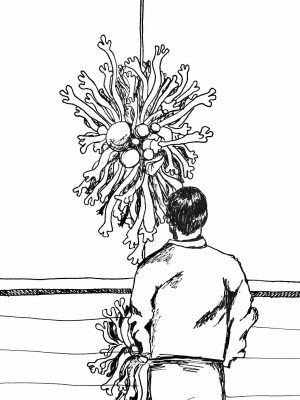Stop staring, protect yourself
October 27, 2016

I have a friend who has an unhealthy penchant for stale metaphor. Just last week we were discussing the Ruth Fluno retrospective at Sheehan when he referred to the art as “a delicious feast.” Normally I’d treat this sort of remark as an empty flourish, but as I was in a slightly unusual state of mind, I immediately began wondering what, exactly, it would mean for art to be delicious. Well, it’d seem to mean that when you look at a piece of art, you are actually consuming it with your eyes and enjoying the taste. What a strange concept, I thought, as I tried to picture beady-eyed connoisseurs consuming paintings by looking at them.
I think there is something wrong here. Unlike food, where proper digestion is necessary for a worthwhile experience, art sometimes becomes more meaningful (and therefore more worthwhile) when there’s regurgitation, aversion and nausea. Take, say, the Chihuly chandelier hanging in Reid. Sure, the fiery colors and smooth curves are pleasant and maybe even a little mouth-watering (there is a certain resemblance to hard candy), but what happens when you take a closer look? You begin to see hands reaching out in all directions, as if desperately trying to escape the inferno. Suddenly you are filled with a sense of dread and avert your gaze. Did the dread somehow detract from the deliciousness of the piece? Is “deliciousness” really the right word here?
Let’s say that you held your gaze—the equivalent of chewing—until you were able to swallow. Suddenly the chandelier no longer exists outside you, but is instead deep in your gut. And what is lost? Everything really meaningful, I think. As soon as you consume the chandelier, the sacred, terrifying and mysterious—what Burke and Kant called “the sublime”—disappears and all that you’re left with is a pretty thing.
But I can take this further. In our day-to-day lives we are constantly faced with the question of whether to consume or regurgitate. When we drive by a car accident on the highway, when a friend says something unwholesome or when we see something distressing in a class we are thrust into that split-second decision. By turning away, we retain a degree of awe—the sense that there’s something bigger than us—that would otherwise be lost if we persevered. And this sense of awe should be celebrated.
I want to make it clear that I’m not extolling the virtues of ignorance—at least, not in the usual sense—but I am advocating an orientation towards life that stresses a form of abstinence. By not directly facing our fears, they begin to take on a form that is deeper—and maybe even truer—than they otherwise would.
In Plato’s Republic, there’s an account of a figure named Leontius who, upon stumbling upon a pile of corpses, is overcome by appetite and shouts, “Look for yourselves, you evil wretches, take your fill of the beautiful sight.” By pointing out the terrible scene he is trivializing it and eliminating the sacred. Death as a concept becomes a closed book, something fully understood and more or less ignored. Paradoxically, this is the result of sight: by seeing the corpses, death is suddenly rendered less meaningful than it actually is.
So, when faced with the sublime, don’t take shame in averting your gaze. Instead recognize that through aversion you might be seeing the truth in what is directly in front of you.





